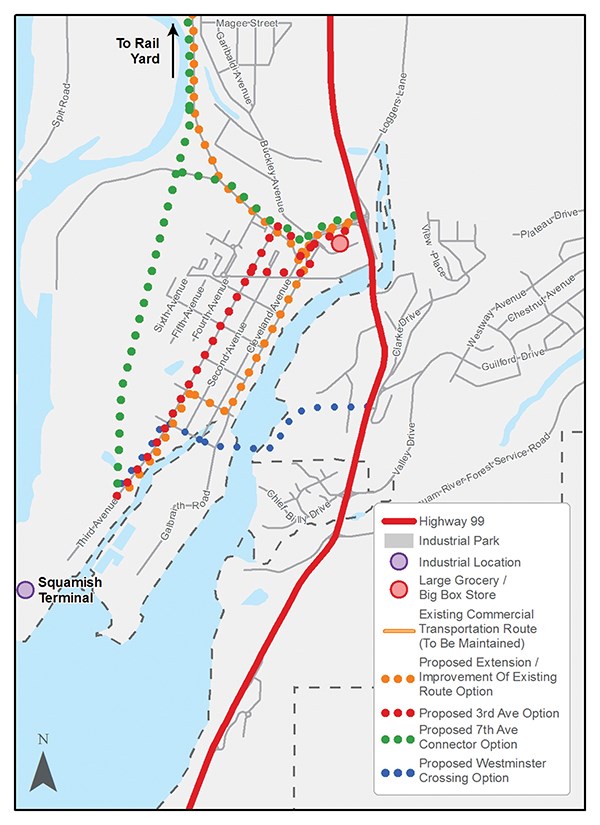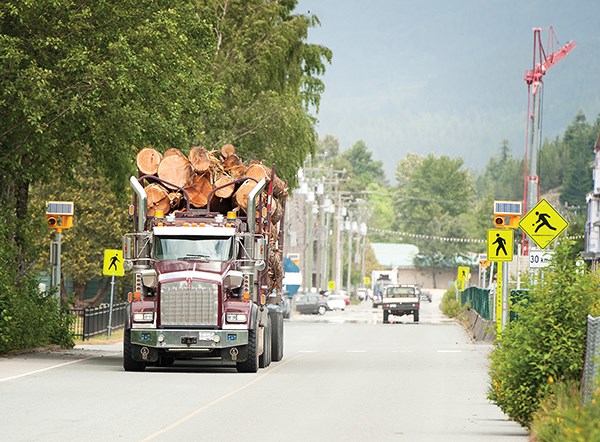By fall, the future truck route through downtown to Squamish’s waterfront may be determined.
Results of the district-commissioned $99,000 district truck route study to look into best route options are expected back in September, according to Rod MacLeod, the district’s director of engineering.
The district is currently soliciting public input on possible routes.
At a public open house May 18, about 65 curious Squamish residents turned out to the Squamish Seniors’ Centre to look at the options and talk with district staff and a few councillors about their concerns.
The same day, district staff also met with key stakeholders including BC Rail, Squamish Terminals, the Squamish and District Forestry Association, the Squamish River Watershed Society, Squamish Environment Society and Squamish Estuary Committee, according to MacLeod.
“And there was a bunch of different points of view,” he said. “We are trying to get… where we can find agreement.”
With the growth of Squamish and the potential for more trucks going through downtown for current and future industry on the waterfront, council determined a safe and efficient truck route needs to be plotted.
The district is also asking residents to fill out a truck route survey, which they will be accepting until June, 1.
Four possible routes are so far being considered: along Loggers Lane, which is the current route; Third Avenue; a Seventh Avenue Connector; or a Mamquam Blind Channel crossing. Exact details of each route have yet to be clarified.
Laura Modray, representing the Squamish Senior Citizens Home Society, said the Third Avenue option should be taken out of the running. “This proposed corridor would have severe impacts to our many seniors living near Third and Pemberton Avenues,” Moray said in a letter to council she forwarded to The Squamish Chief.
“Safety is our number one area of concern. Many of our tenants have difficulty crossing over the intersection at Pemberton and Third Avenue based on the existing traffic levels. Increased truck volume will only make this crossing more dangerous.”
Local resident Graham Fuller, on a post to the district’s website, agreed the Third Avenue option was not ideal. He also objected to the Seventh Avenue Connector because of its risk to the Squamish Estuary. “All things considered, the Westminster Crossing [over the blind channel] would seem to create least damage to the estuary or to the nature of downtown as a residential, commercial and recreational location. It can go through now, where the area has not been well developed yet, with the least disruption to the downtown,” he said.
Councillor Ted Prior told The Squamish Chief opinions seem to be divided along philosophical lines.
“There’s three trains of thought: the environmental people don’t want the Seventh Avenue Connector going through the estuary, the seniors and school children and mothers don’t want it going down Third Avenue, and the developers and downtown businesses don’t want it going down Loggers Lane,” he said, adding he doesn’t have his own opinion at this point.
Councillor Jason Blackman-Wulff said he looks forward to more data being available through the study to help guide council, “so we know what the scale of the issue is,” he said. “To say how many trucks are going to Squamish Terminals, and is that forecasted to increase or decrease? And also, we know that the oceanfront development is happening and that will probably see the change in the log sort that is on our side of the water. In all likelihood, that area will transition to something else, so are we going to have big trucks going down there on a regular basis?”
Blackman-Wulff said he would also like to investigate some out of the box options.
“I would be very interested to see what other options there are,” he said. “Other jurisdictions like Long Beach [California], for example. The Port of Los Angeles, one of the things they do is they route by a short line railway that is electrified, they move cargo into the outskirts of town and then that way trucks can connect via the interstate, they don’t have to go near residential neighbourhoods.”
Councillor Susan Chapelle did not comment on any particular option but said she does not support large diesel vehicles heading through populated areas because of the risk of lung cancer.
“There is nowhere that allows large trucks to travel through populated areas,” she said. “Diesel fumes are a known carcinogen, and I would not support truck density in an area with children or seniors.”
Councillor Karen Elliott said like with other major decisions that have faced council, determining the truck route is going to require balancing social, health, environmental and economic values and viewpoints. “This is going to be another one of those instances where that is critical,” she said.
To fill out the truck route survey, go to Squamish.ca and search Truck Route Study.




